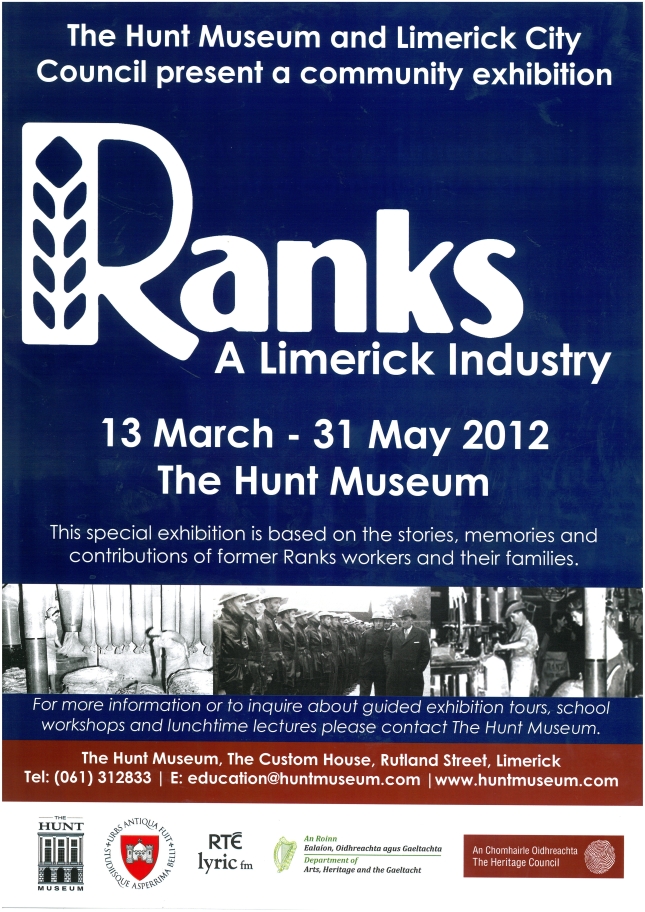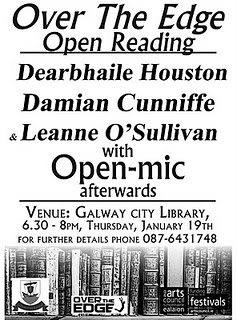Ranks – A Limerick Industry (Exhibition)
The Limerick City Archives in collaboration with the Hunt Museum has launched a unique exhibition this evening (Tuesday) on the former Ranks Flour Mills titled Ranks A Limerick Industry. This exhibition is a collaboration between Limerick City Archives and the Hunt Museum and is based on the stories, memories and contributions of former Ranks workers and their families.
Ranks Flour Mills and grain ships were a crucial part of Limerick life over a span of several decades and it’s legacy provides an excellent example of life and work in Limerick’s recent past.
Through interpretative panels, installations, photographs, documents, industrial equipment and memorabilia the story of the working and social life of the Ranks workers is told. The exhibition will run from 13th March – 31st May 2012 at the Hunt Museum on Rutland St.
The acquisition of the Limerick Mills by Ranks in 1930 was hugely controversial as Ranks was a British company. However the company grew to the biggest or second biggest flour mill in the state during the Emergency. The mill gained further profitability during the 1960s but in the 1970s the company began to lose market share as Ireland’s accession to the EEC opened up the Irish flour market to cheap imports. Rank eventually closed in 1983.
An Oral History Project was organised with the assistance of Mary Immaculate College, staff and students. Through a series of interviews Limerick City Council sought to record the experiences of those employed by Ranks.
City Archivist, Jacqui Hayes said “Over the past year Limerick City Council have conducted a series of oral history interviews and received material from former Ranks workers including an old wheat shovel, an old bastible for baking bread, a clock that was a given as a retirement present & even a high Nelly bicycle!”
Ranks reached into every home in Ireland with its products and advertisements. Its marketing strategy and brand awareness made it a recognisable household name. Traditionally Ranks was regarded as a good place to work, one that paid good wages, even contractors or casual workers were relatively well paid.
From an early date the Shannon Mills offered their employees benefits that few other workers locally or nationally received including the introduction of a pension scheme in 1947.
Tony Clohessy, a former employee remembers, “It was a happy-go-lucky place. Industrial relations were very good compared to other places a lot of companies around town were bad- never strikes there-everything was negotiated- the management contributed to the atmosphere- it was all first names unless you wanted it otherwise…Ranks was different- a pleasure.”
Future plans for the Ranks story are already in place. The City’s Archives commitment is to not just to record and preserve the people’s history but to bring our heritage to as wide an audience as possible. Alongside the publication of a book- the archives are opening a website dedicated to Ranks history and in co-operation with the Hunt Museum will host an exhibition dedicated to the Limerick Mills.
For more information or to enquire about guided exhibition tours, school workshops and lunchtime lectures please contact The Hunt Museum contact the Hunt Museum on +353 61 312833.



 “I was aware that the role was a coveted one I wanted to apply to the position with a unique CV, so I decided I would draw each of the theatres listed on their website (16 in total) and create a booklet that would also display the drawings. Motivated by the deadline that the Festival applications had to be in by, I took a rare sunny evening out last June and cycled a full circle of the city, visiting 13 of the 16 theatres. (I visited the remaining three at different times as they were in the suburbs.) I spent a bit of time at each theatre, taking photos from all angles before cycling on to the next.”
“I was aware that the role was a coveted one I wanted to apply to the position with a unique CV, so I decided I would draw each of the theatres listed on their website (16 in total) and create a booklet that would also display the drawings. Motivated by the deadline that the Festival applications had to be in by, I took a rare sunny evening out last June and cycled a full circle of the city, visiting 13 of the 16 theatres. (I visited the remaining three at different times as they were in the suburbs.) I spent a bit of time at each theatre, taking photos from all angles before cycling on to the next.”










